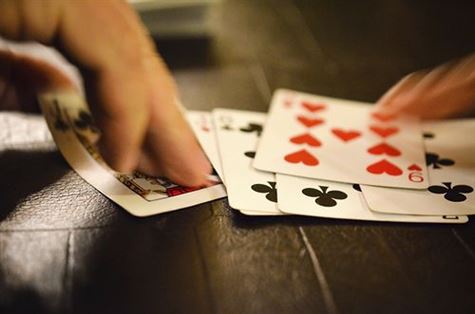“Beyond the Basics: Advanced Strategies for Lesser-Known Poker Variants” is a comprehensive guide that delves into the intricacies of various poker variants that are not as widely known or played as the traditional Texas Hold’em. This guide aims to provide experienced poker players with advanced strategies and techniques specifically tailored for these lesser-known variants. By exploring the nuances and unique aspects of these games, readers can enhance their skills and gain a competitive edge in a wider range of poker variations.
Advanced Strategies for Stud Poker Variants
One of the key aspects of stud poker is the ability to read your opponents and make educated guesses about the cards they hold. This is especially important in stud poker, as players are dealt a combination of face-up and face-down cards. By carefully observing the cards that are visible to all players, you can make inferences about the strength of your opponents’ hands.
Another important strategy in stud poker is to carefully manage your betting. Unlike other variants of poker, where players have the opportunity to fold and cut their losses, in stud poker, players must continue to bet until the end of the hand. This means that you need to be strategic in your betting, only putting money into the pot when you have a strong hand or when you believe you can bluff your opponents into folding.
In addition to reading your opponents and managing your betting, another advanced strategy in stud poker is to carefully consider the cards that have already been dealt. By keeping track of the cards that have been folded or are visible on the table, you can make more accurate predictions about the cards that are still in play. This can give you a significant advantage when it comes to making decisions about whether to bet, raise, or fold.
Furthermore, it is important to be aware of the different variations of stud poker and adjust your strategy accordingly. For example, in Seven-Card Stud, where each player is dealt seven cards, it is crucial to pay attention to the cards that are visible on the table and the cards that have been folded. This will help you make informed decisions about the strength of your hand and the likelihood of your opponents having strong hands.
Lastly, one of the most important advanced strategies in stud poker is to remain disciplined and patient. Stud poker can be a slow-paced game, with many rounds of betting and multiple opportunities to make decisions. It is important to resist the temptation to make impulsive or emotional decisions and instead, carefully consider each move. By remaining disciplined and patient, you can avoid making costly mistakes and increase your chances of success.
Mastering Omaha Hi-Lo: Advanced Tactics and Techniques
Omaha Hi-Lo is similar to Omaha Hold’em, but with a twist. In this game, the pot is split between the best high hand and the best low hand. This adds an extra layer of complexity to the game, as players must consider both their high and low possibilities when making decisions.
To truly master Omaha Hi-Lo, players must understand and employ advanced tactics and techniques. One such tactic is the concept of scooping the pot. Scooping occurs when a player wins both the high and low halves of the pot. This is the ultimate goal in Omaha Hi-Lo, as it allows players to maximize their winnings.
To increase your chances of scooping, it is important to carefully select starting hands. In Omaha Hi-Lo, it is crucial to have hands that can potentially win both the high and low halves of the pot. Hands with strong high potential, such as A-A-2-3, are ideal, as they give you a chance to win the high half of the pot. Additionally, hands with strong low potential, such as A-2-3-4, are also valuable, as they give you a chance to win the low half of the pot. By selecting starting hands that have the potential to win both halves, you increase your chances of scooping the pot.
Another important tactic in Omaha Hi-Lo is the concept of playing for the nuts. The nuts refers to the best possible hand at any given moment. In Omaha Hi-Lo, the nuts can change with each new card that is dealt. Therefore, it is important to constantly reassess the strength of your hand and adjust your strategy accordingly. Playing for the nuts means striving to have the best possible hand at all times, whether it be the best high hand or the best low hand. By playing for the nuts, you increase your chances of winning a larger portion of the pot.
In addition to these tactics, there are also several techniques that can help improve your Omaha Hi-Lo game. One such technique is the art of reading your opponents. In poker, being able to accurately read your opponents’ intentions and tendencies can give you a significant advantage. This is especially true in Omaha Hi-Lo, where players must consider both their high and low possibilities. By carefully observing your opponents’ betting patterns and body language, you can gain valuable insights into their hand strength and make more informed decisions.
Furthermore, it is important to be mindful of your position at the table. In Omaha Hi-Lo, your position can greatly impact the strength of your hand. Being in a late position allows you to see how your opponents have acted before making your own decision. This can give you valuable information about the strength of their hands and help you make more strategic choices.
Unleashing Your Skills in Razz Poker: Advanced Strategies for Success
One of the key differences in Razz Poker is that the goal is to make the lowest possible hand instead of the highest. This means that traditional poker hands like straights and flushes are not desirable in Razz. Instead, players aim for hands with low-ranking cards, ideally with no pairs or sets.
To succeed in Razz Poker, it is crucial to have a solid understanding of the starting hands. Unlike other variants, where strong starting hands are often obvious, Razz requires a more nuanced approach. Starting with three low cards, ideally below 8, is generally a good strategy. However, it is important to consider the door card, which is the exposed card of each player. If your door card is higher than your opponents’, it may be wise to fold and wait for a better opportunity.
Another important aspect of Razz Poker is the concept of stealing antes. Antes are small bets that all players must contribute before each hand. In Razz, stealing antes can be a highly effective strategy to accumulate chips and put pressure on your opponents. This can be done by raising with a strong door card and forcing your opponents to fold if they have weak hands. However, it is crucial to be mindful of your own hand strength and not overcommit to stealing antes if your hand is not strong enough.
Bluffing is another strategy that can be effective in Razz Poker, although it requires careful execution. Since the goal is to make the lowest hand, players are often more cautious and less likely to call large bets. This creates an opportunity for skilled players to bluff and represent a strong hand. However, bluffing in Razz requires a deep understanding of your opponents’ tendencies and the ability to read their door cards. It is important to pick your spots wisely and not overuse this strategy, as it can easily backfire if your opponents catch on.
Position is also a crucial factor in Razz Poker. Being in a late position allows you to have more information about your opponents’ hands before making your own decisions. This can be a significant advantage, as it allows you to adjust your strategy accordingly. For example, if you are in a late position and notice that your opponents have weak door cards, you can be more aggressive and raise with a wider range of starting hands.
Advanced Tips for Mixed Game Variants: Maximizing Your Edge
One of the key strategies for excelling in mixed game variants is to have a solid understanding of each individual game that makes up the variant. These games can include classics like Stud, Razz, and Badugi, as well as lesser-known games like 2-7 Triple Draw and Chinese Poker. By mastering the rules, hand rankings, and optimal strategies for each game, players can gain a significant advantage over their opponents.
Another important aspect of maximizing your edge in mixed game variants is to be adaptable and flexible in your playing style. Unlike traditional poker variants where you can focus on a single game and develop a specific strategy, mixed game variants require players to switch between different games and adjust their strategies accordingly. This means being able to quickly analyze the dynamics of each game and make informed decisions based on the specific rules and circumstances.
One effective strategy for adapting to different games in mixed game variants is to identify the common elements and patterns across the games. While each game may have its unique rules and strategies, there are often similarities in terms of hand rankings, betting structures, and bluffing opportunities. By recognizing these common elements, players can apply their knowledge and skills from one game to another, giving them a competitive edge.
In addition to being adaptable, it is crucial to pay close attention to your opponents’ playing styles and tendencies in mixed game variants. Since these variants attract a smaller pool of players compared to popular variants like Texas Hold’em, you are more likely to encounter the same opponents repeatedly. This presents a unique opportunity to study their playing styles, identify their strengths and weaknesses, and adjust your strategies accordingly.
One effective way to exploit your opponents’ weaknesses in mixed game variants is to focus on the games they are less proficient in. For example, if you notice that a particular opponent struggles with Razz, you can target them in that game and exploit their mistakes. By capitalizing on your opponents’ weaknesses, you can increase your chances of winning and maximize your edge in the overall variant.
Lastly, it is essential to continuously improve your skills and knowledge in mixed game variants. This can be done through studying poker literature, watching instructional videos, and participating in online forums and discussion groups. By staying up to date with the latest strategies and developments in these variants, you can stay one step ahead of your opponents and maintain a competitive edge.
Elevating Your Game in Badugi: Advanced Strategies for Winning
Badugi is a draw poker game that is played with four cards instead of the traditional five. The objective of the game is to make the lowest possible hand with four different suits and no pairs. The best possible hand in Badugi is A-2-3-4 of different suits, also known as a Badugi. As with any poker game, the key to success in Badugi lies in understanding the odds, reading your opponents, and making the right decisions at the right time.
One of the most important strategies in Badugi is hand selection. Since the goal is to make the lowest possible hand, it is crucial to start with strong starting hands. Ideally, you want to start with four low cards of different suits. Hands like A-2-3-4 or 2-3-4-5 are considered premium starting hands in Badugi. However, it is important to note that the strength of your hand can change dramatically with each draw, so it is essential to adapt your strategy accordingly.
Position is another crucial factor in Badugi. Just like in other poker games, being in late position gives you a significant advantage. It allows you to see what your opponents do before making your decision, giving you valuable information to make the best play. In Badugi, being in late position allows you to see how many cards your opponents draw, which can give you insight into the strength of their hands. This information can be used to your advantage when deciding whether to draw or stand pat.
Drawing strategy is another important aspect of Badugi. In general, you want to draw as few cards as possible to improve your hand. However, there are situations where drawing more cards can be beneficial. For example, if you have a strong starting hand like A-2-3-4, you may choose to stand pat and hope that your opponents draw to weaker hands. On the other hand, if you have a weak starting hand, drawing more cards can give you a chance to improve your hand and compete with stronger hands.
Bluffing is also a crucial skill in Badugi. Since the game is based on making the lowest hand, players tend to be more cautious and fold more often. This creates opportunities for well-timed bluffs. Bluffing in Badugi requires careful observation of your opponents’ betting patterns and tendencies. Look for signs of weakness, such as hesitation or reluctance to bet, and take advantage of these opportunities to bluff and steal pots.
Finally, it is important to be aware of your table image in Badugi. Your table image is how your opponents perceive you and can greatly influence their decisions. If you have been playing tight and conservative, your opponents are more likely to give you credit for a strong hand when you bet or raise. Conversely, if you have been playing loose and aggressive, your opponents may be more inclined to call or even bluff against you. By being aware of your table image, you can use it to your advantage and manipulate your opponents’ decisions.
In conclusion, Badugi is a challenging and exciting poker variant that requires advanced strategies to succeed. By understanding hand selection, position, drawing strategy, bluffing, and table image, you can elevate your game and increase your chances of winning. Remember, practice makes perfect, so take the time to study and master these strategies, and you will be well on your way to becoming a formidable Badugi player.




